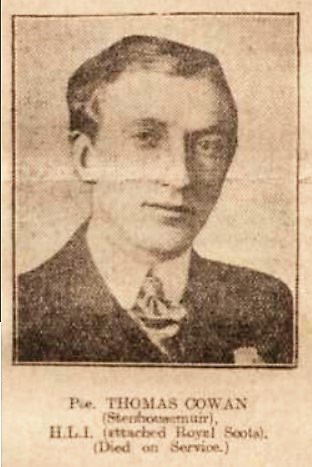MacGillivary/Scott transcription
47903 THOMAS COWAN
4th Bn Royal Scots
Husband of Catherine Richardson Cowan, father of “wee” son Jackie; son of Isabella Forsyth Cowan and the late John Cowan. (IS/RMcG)
This section is a transcription of the work of Russell MacGillivary unless otherwise identified
Born Letham, Carronshore.
Died of pneumonia, 26th October 1918 in
Service Number: 47903
Date of Death: 26 October 1918
Age at Death: 27
Thomas Cowan was born in Letham, worked as a miner at Letham Pit and lived at 38 Letham Cottages prior to joining the 3rd Battalion HLI in April 1917.
He had been on the Army Reserve list for over a year. In December that year he arrived in Egypt to serve with the British forces in Palestine. In February 1918 he applied for a transfer to the 1st/4th Royal Scots so that he could serve with his younger brother. This transfer was allowed. Thomas was said to be of “good character, 1st Class Shot, 1st Class Signaller”.
In April as a result of the German Spring Offensive, the “Kaiserschlacht” Thomas’ battalion was sent to the Western Front in the wake of the heavy losses . A month later, he was taken ill with influenza and was in hospital for four days.
The first operations that the battalion was involved in on the Western Front in 1918 took place between August 23 and 27.
Russell MacGillivary
The Hundred Days Offensive (8 August to 11 November 1918) was a series of massive Allied offensives which ended the First World War.
Beginning with the Battle of Amiens (8–12 August) on the Western Front, the Allies pushed the Central powers back, undoing their gains from the German Spring Offensive which had come close to breaking through to victory.
The Germans retreated to the Hindenburg Line, but the Allies broke through the line with a series of victories, starting with the Battle of St Quentin on 29 September. The offensive, led to the Armistice of November 1918 which ended the war with an Allied victory.
The term "Hundred Days Offensive" does not refer to a battle or strategy, but rather the rapid series of Allied victories against which the German Army had no reply.
“There was considerable difficulty getting to the assembly line owing to the great congestion of military traffic”. Zero hour on the 23rd was 4.55 a.m. The battalion followed a creeping barrage and “gained their objectives without great opposition”. A second attack wave with three tanks advanced the battalion line 400 yards. During the night one battalion company was sent forward to fill a gap of 1200 yards between the two neighbouring brigades. The battalion war diary reported: “This area was severely shelled with gas shells and being low-lying there was heavy gas concentration necessitating the Coy to wearing their masks for the greater part of the night.” The next objective of the battalion was to move into part of the Hindenburg Line north of the River Cojeul. This was accomplished in an attack which was carried out between 10 a.m. and 2 p.m. on August 27, despite the troops on both flanks not making anything like the same progress as the Royal Scots had.
The battalion captured the village of Fontaine-les-Croisilles, which “in former years… would have been a tough nut to crack, but it fell into the hands of the 4th Royal Scots with astonishing ease; many Germans threw down their weapons with a readiness that was almost indecent and gladly surrendered in order to get out of a war from which they longer expected profit or victory”.
Four German officers and 340 men were taken prisoner as well as 25 machine guns and “an immense quantity of ammunition”.
These two attacks caused the battalion five casualties among its officers and 240 in the other ranks. It is most likely that Thomas earned his Military Medal during one of these attacks.”




